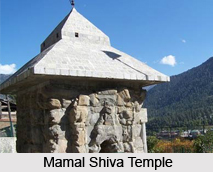 Mamal Shiva Temple is located just opposite to the Rest House in Pahalgam in Srinagar district. It is an ancient temple dating back to the 5th century on the banks of the Lidder River. Understandably, the temple is dedicated to Lord Shiva.
Mamal Shiva Temple is located just opposite to the Rest House in Pahalgam in Srinagar district. It is an ancient temple dating back to the 5th century on the banks of the Lidder River. Understandably, the temple is dedicated to Lord Shiva.
A Shivalingam (a symbolic phallus representation of the Lord) is established inside the sanctum. Even though a major portion of the temple is in wreckings, despite that devotees throng this temple in huge numbers. It is believed that Mamal Shiva Temple is the oldest existing temple in Kashmir. The enarest railhead is Jammu Tawi railway station; Pahalgam is well connected by road to Srinagar.
This article is a stub. You can enrich by adding more information to it. Send your Write Up to content@indianetzone.com





















